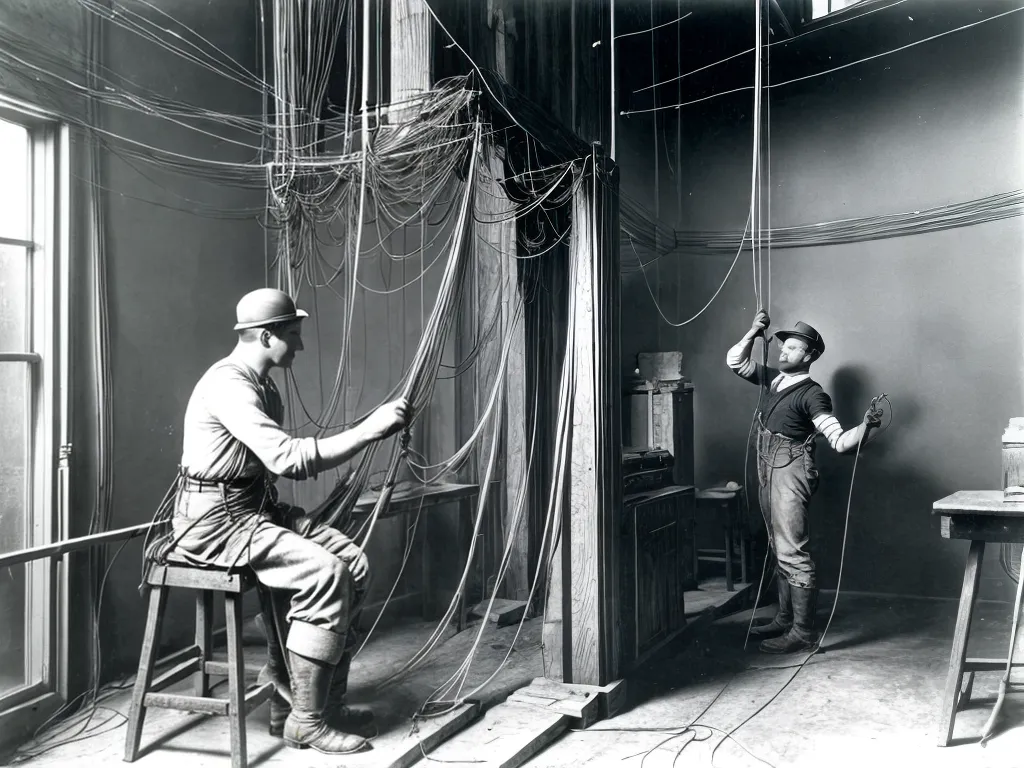
How Early Electricians Strung Wires Before Romex
As an early electrician working before modern wiring methods like Romex were widely available, we had to be creative and resourceful to bring electricity into buildings. Here's an in-depth look at how we got the job done in those pioneering days of electrical work.
Using Knob and Tube Wiring
The most common early wiring method was knob and tube wiring. This involved running wires through ceramic knobs mounted to surfaces like walls and ceilings. The wires were separated by at least one inch and often ran through hollow tubes to protect them at key points like holes through walls.
Advantages:
- Allowed wires to be run safely through open spaces in walls and ceilings
- Air gaps around wires provided excellent insulation and cooling
Disadvantages:
- Difficult to install in finished walls since it required access along entire run
- Rigid knobs allowed little flexibility in wire routing
- Labor-intensive compared to modern Romex wiring
While clumsy by today's standards, knob and tube let us bring basic electricity into many early 20th century homes and commercial buildings.
Using Conduit
For more heavy-duty wiring, we used electrical conduit - hollow metal or fiber tubes through which we pulled copper wires. Conduit provided sturdy mechanical protection and made pulls easier around corners or between floors.
Common conduit types:
- Rigid metal conduit - thick steel, excellent durability
- Electrical metallic tubing (EMT) - thin steel, more flexible
- Flexible metal conduit - wrapped steel, easy bends
- Nonmetallic conduit - plastic or fiber, corrosion resistance
We had to plan conduit runs carefully since wires were difficult to pull through multiple bends. But conduit let us safely feed electricity to large equipment like industrial motors.
Other Early Wiring Methods
Beyond knob and tube and conduit, we had a few other early ways to run wires:
- Metal raceways - early surface-mounted metal channels
- Armored cable - insulated wires wrapped in metal tape and fiber
- Nonmetallic sheathed cable - rubber-insulated wires with fabric wrap
These were transition methods on the road from knob and tube to modern Romex and conduit wiring. We used them in specific applications before more advanced methods matured.
Working Without Modern Tools
Installing wiring was tough without modern luxuries like cable staplers and battery-powered drills. We had to improvise tools using what was available:
- Hand-cranked drills -slow and tiring but got holes drilled
- Mallets - hammered ceramic knobs into wood framing
- Hand benders - used muscle to bend conduit
- Fish tape - flexible steel tape to pull wires
It required lots of sweat and elbow grease! But it meant satisfying work bringing electricity and new technology to more and more people. We took pride in the wiring craftsmanship we achieved.
Learning the Electrical Code
Early electricians had to stay on top of the National Electrical Code (NEC) adopted in 1897 to ensure safety. For example, the NEC established:
- Requirements for proper grounding and insulation
- Minimum separation distances between wiring
- Specs for materials and installation methods
- Rules for devices like fuses and switches
Studying the code and passing inspections was crucial. Like today, we tried to go above and beyond code to future-proof and over-engineer our work.
Apprenticing in the Trade
Most electricians back then learned the trade through multi-year apprenticeships under veteran wiremen. Knowledge was passed down on the job. My mentor taught me:
- How to plan logical wiring routes
- Tricks for safely pulling wires
- Neat work habits to impress customers
- Pride in craftsmanship that lasts decades
It was a different time before modern electrical programs. We studied under the old tradesmen until it came time for us to train the next generation.
The early days of wiring homes and buildings required patience and determination. But it was deeply rewarding work powering society's technological revolution. I'm proud of the wires we meticulously installed that served communities for generations.